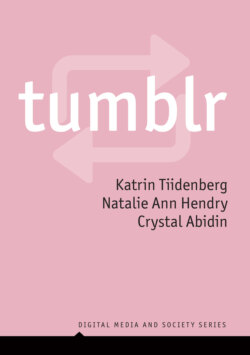Tumblr

Реклама. ООО «ЛитРес», ИНН: 7719571260.
Оглавление
Crystal Abidin. Tumblr
Table of Contents
Guide
Pages
Digital Media and Society Series
tumblr
Copyright page
Acknowledgments
Prologue
Introduction: tumblr, with a small t
History, ownership, and vision
Independent tumblr
Yahoo! tumblr
Automattic tumblr
Magic and frisson
tumblr is a silosocial platform
What is in this book
Our research methods
Notes
1 tumblr structure
Features and functions
Setting up and posting
Reblogs
Tags
Interaction
Governance
Moderating participants and practices
Moderating content
Algorithms
Conclusion
Notes
2 tumblr sociality
tumblr affordances
tumblr vernacular
Curatorial
Multimodal, multiliterate, and affective
Expressed through personal testimonials
Interest and affinity based
tumblr sensibility
Silosociality
What are silos?
How does silosociality function?
Broader implications of silosociality
Conclusion
Notes
3 fame
Attention flows
Discursive strategies for attention hacking
Linguistic wit
Call-out culture
Perpetual arrested development
Self-care
Self-deprecation and helplessness
Queer normativity
Commerce on tumblr
Platform commerce, the business model
E-commerce
Creative advertising campaigns
Creatrs Network and paid ad spaces
Brand commerce
Vernacular commerce
Mainstream celebrities
Microcelebrities and Influencers
Everyday users
(A) Advertisement placing services and affiliate networks
(B) Start a small business
(C) Replicate posting norms within a silo
Conclusion
Notes
4 fandom
Existing research
Corporate fandom: Fandometrics
K-pop fandom
Digital shrines
Screengrabs and archives
Creating fan art
Curatorial fan fiction
Confessions
Social justice within K-pop fandoms
Community making and networked gatekeeping
Fandom of tumblr, or, “Just tumblr things”
Fandom of tumblr feels
Fandom of tumblr folklore
Fandom of tumblr’s features and functions
Fandom of broken tumblr
Fandom of weird mutuals
Fandom of tumblr nostalgia
Conclusion
Notes
5 social justice
Digital activism and social justice
Tumblr Inc.’s social justice
Practices for social justice
Safer spaces
Pedagogy for social change
Social justice warriors
Virtue signaling, clicktivism, and brandjacking
Call out cultures and dogpiling
Queer silosociality
Queer identity curation
Overwhelming connection
Emerging taxonomies
Conclusion
Notes
6 NSFW
NSFW community as a safe space
Learning and empathy
Finding and using a voice
“tumblr doms” and image-based sexual abuse
NSFW ≠ porn
Conclusion
Notes
7 mental health
Mental health and mental illness
tumblr freedom and “like-others”
Searching for and tagging mental health experiences
Legitimizing mental illness challenges
Circulating toxic feelings and triggers
Laughing and relating to sadness and pain
“Invisible” mental illness feels
Romanticizing mental illness?
Conclusion
Notes
Conclusion: “beautiful hellsite”
RIP tumblr
Mutating tumblr
Escape and irrelevance
Silosocial futures
Notes
References
Index
POLITY END USER LICENSE AGREEMENT
Отрывок из книги
Katrin Tiidenberg, Natalie Ann Hendry, and Crystal Abidin
We especially would like to thank: Kath Albury, Airi-Alina Allaste, Steven Angelides, Nancy Baym, Megan Lindsay Brown, Michael Burnam-Fink, Paul Byron, Earvin Cabalquinto, Alexander Cho, Edgar Gómez Cruz, Debra Ferreday, Robbie Fordyce, Ysabel Gerrard, Ben Hanckel, Matt Hart, Larissa Hjorth, Amelia Johns, Akane Kanai, Annette Markham, Anthony McCosker, Allison McCracken, John Carter McKnight, Kristian Møller, Susanna Paasonen, Daniel Reeders, Bryce Renninger, Brady Robards, Jenny Robinson, Julian Sefton-Green, Terri Senft, Frances Shaw, Daphanie Teo, Cindy Tekobbe, Emily van der Nagel, Son Vivienne, Katie Warfield, Rosie Welch, and Andrew Whelan.
.....
Social media are diverse, but public imaginaries of their functions and implications are dominated by Facebook. Scholarship too, is heavily skewed toward Facebook (given its popularity worldwide), and also Twitter (given its high accessibility for researchers to extract data via the API). Generalist discussions and critiques of social media therefore often presume that social media sociality4 is profile-based and built on what is called the social graph and the ego network.5 In the case of Facebook, egos in the graph are represented by profiles – descriptions of the account owner’s social characteristics, often in the form of answers to questions, sometimes via predetermined options. This version of social media sociality is linked to individual connections and has been multiply critiqued in the past decade: as networked individualism (Wellman 2002), as people converging around someone’s profile or interacting in dyads instead of converging around interests (Baym 2010), as leading to context collapse resulting from the inability to modulate one’s self presentations to different audiences (Marwick and boyd 2011), as fostering a culture of connectivity instead one of connection (van Dijck 2013), or even as antisocial, because it discourages deliberation (Vaidhyanathan 2018).
The following are generalizations, of course, but they reflect dominant trends on platforms and, more importantly, dominant imaginaries about the platforms, which together converge into an increasingly popular narrative of a broken internet (Berners-Lee 2019; Phillips 2020). Facebook started out as a social ego network intended for interpersonal interaction, but has, according to American media scholar Siva Vaidhyanathan (2018), devolved into a network of amplified prejudices and predilections. Twitter, according to media and communication scholars Jean Burgess and Nancy Baym (2020: 13), remains unsure whether it should be a social network or an information network, and which of the two is a more valuable form of human communication, even if the founders themselves have framed the platform’s transformation “from a me-centered, personal, and intimate Twitter, to a world-centered, public, and newsy one” as progress. Instagram, as argued by internet researchers Tama Leaver, Tim Highfield, and Crystal Abidin (2020), increasingly functions as a communication and commerce network, where sociality is template-based and communication rarely leads to collective experiences (Leaver and Highfield 2018). In contrast, tumblr’s features, functions, governance, and user cultures – as we will go on to show – differ significantly from these popular platforms. tumblr is a social network, but not profile-based or legal name-linked, and welcomes multifaceted self-presentation; it is informative, but through educational rather than newsy ways; attention flows and converges on it but is linked differently to commerce than elsewhere.
.....